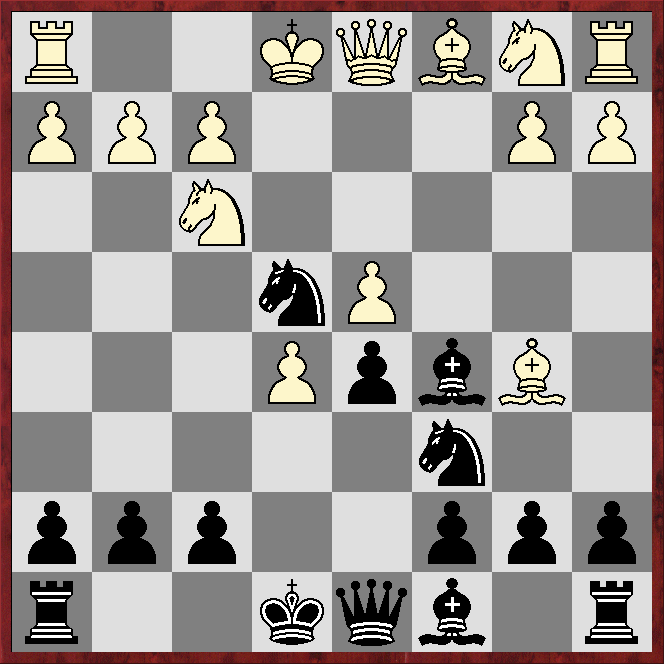Scotch Gambit/Giuoco Piano
1.e4 e5 2.Nf3 Nc6 3.d4 exd4 4.Bc4!?
There are 31,890 examples of this move in ChessBase's 2023 Mega database, where it scores 57% - two percentage points higher than the more popular 4.Nxd4.
4...Bc5!?
Black scores 45% with this in Mega23 - four percentage points lower than with the main move 4...Nf6, which reaches a position that also arises from the Two Knights Defence.
5.c3 Nf6
Very risky is 5...dxc3!? 6.Bxf7+! Kxf7 7.Qd5+, after which White regains at least the sacrificed bishop, eg 7...Ke8 8.Qh5+ Kf8 9.Qxc5+ d6 10.Qxc3 with clearly the better game.
 |
| The position after 5...Nf6 frequently arises from the Giuoco Piano via the move-order 1.e4 e5 2.Nf3 Nc6 3.Bc4 Bc5 4.c3 Nf6 5.d4 exd4 |
*****
*****
*****
*****
*****
6.e5!?
Stockfish16 and Komodo14.1 prefer this marginally - very marginally in the case of the former - over the much more common 6.cxd4.
6...d5
As is well-known, ...d5 is often the best reply in open games when White thrusts with e5.
7.Bb5
Trendy at the elite level in recent years has been 7.Be2!?, although the engines reckon 7...Ne4 is a complete equaliser. Not popular at the top is 7.exf6!? dxc4 8.fxg7 Rg8, which at first glance may look promising for White, but practice strongly favours Black.
7...Ne4 8.cxd4
*****
*****
*****
*****
8...Bb6
This is the mainline in modern times, although grandmasters also play 8...Be7 and especially 8...Bb4+. After the latter White usually offers the bishop-pair with 9.Bd2!?, when 9...Nxd2 10.Nbxd2 0-0 11.0-0 leaves White slightly better, according to Komodo14.1, although Stockfish16 is less sure.
9.Be3!?
More popular are 9.0-0 and especially 9.Nc3.
9...0-0 10.Nc3 Nxc3!?
Komodo14.1 likes this relatively rare continuation, but Stockfish16 prefers the main move 10....Bg4 or 10...f5.
11.bxc3 Ne7!?
Avoiding doubled pawns and preparing to contest the b1-h7 diagonal. The engines prefer attacking the white centre with 11...f6.
12.Bd3 Bf5 13.0-0 Qd7 14.Rb1!?
This useful-looking developing move may be a novelty. Several high-level games have seen 14.Nh4 Bxd3 15.Qxd3 f5, with advantage to White, according to the engines.
14...c6
The engines suggest 14...Rac8!? with the idea of breaking with ...c5.
15.Bg5 Bxd3 16.Qxd3 h6 17.Bc1
The engines reckon White should take the chance to swop off the bad dark-square bishop.
17...Ng6 18.h3 Bd8?!
This is probably too slow. The engines advocate 18...Rac8, again with the idea of trying to get in ...c5.
19.Nh2
White's unchallenged central space advantage, in a position in which the centre is unlikely to open soon, means he has time to launch a kingside attack.
*****
*****
*****
*****
19...b5
Freeing Black's pieces from having to defend the b pawn. The engines prefer sacrificing it with 19...Nh4 20.f4 Qf5!? After 21.Qxf5 Nxf5 22.Ba3 Re8 23.Rxb7 the black knight is active, but that is not sufficient compensation. If instead of giving up a pawn, Black tries 20...Nf5, White has 21.g4 and 22.f5 with promising play.
20.f4 f5 21.exf6 Rxf6 22.Ng4 Rf5 23.Ne3 Rf6
Not 23...Nxf4? 24.Qxf5 Ne2+ as Black gets nowhere enough for a rook after either 25.Kf2!? or 25.Kh2.
24.Ng4 Rf5 25.Ne3 Rf6
*****
*****
*****
*****
26.f5
White is winning, according to the engines.
26...Ne7
After 26...Nh4?! White can go after the knight immediately with 27.g3 Qd6 28.Ng4, but even stronger, according to the engines, is to first play 27.Bd2.
27.Ng4?!
This seems to let most of White's advantage slip. Best, according to the engines, is 27.Ba3!?, eg 27...h5 28.Rbe1 Nc8 29.g4 Rf7 30.gxh5!? Be7 31.Bc5 Nd6 32.Bxd6 Bxd6 33.Ng4 Raf8 34.f6 with a very strong attack.
27...Rxf5 28.Bxh6!? Bc7
Very bad is 28...gxh6?? 29.Nxh6+ and Nxf5(+). Black is also in trouble after 28...Rxf1+? 29.Rxf1 as in effect Black's active king's rook has been swopped for White's inactive queen's rook.
29.Rbe1 Raf8 30.Bc1 Rxf1+ 31.Rxf1 Rxf1+ 32.Kxf1!?
The engines reckon this is playable, but the king was safer where it was.
32...Nf5 33.Qf3?!
Probably better is 33.Ne5!?, or continuing to run to the queenside with 33.Ke1!?
33...Ng3+ 34.Ke1
It is perhaps too late to go back as 34.Kg1 can be met by 34...Qe6, eg 35.Bd2 Qg6 36.Qe3 Qb1+ 37.Qe1 Qf5!? 38.Nf2 Bd6 with continuing pressure.
34...Qe7+ 35.Qe3
The engines suggest 35.Kd1, but with a slight edge for Black (and with practical difficulties thanks to the exposed white king).
35...Ne4 36.Kd1 b4 37.cxb4?
This loses. White has to play 37.Kc2!?, according to the engines, but a tough defensive task lies ahead as White seems to have no counterplay.
37...Qxb4 38.a3?!
Best, according to the engines, is giving up the a pawn with 38.Qd3!? Qa4+ 39.Ke2 (39.Qb3 Qxd4+) Qxa2+ 40.Kf3, but Black is winning.
38...Qa4+ 39.Ke2
39.Ke1 Ba5+ is not an improvement.
39...Qc4+ 40.Kf3
Slightly better is 40.Kd1, but 40...Bd8!, among other moves, is deeply unpleasant.
40...Qf1+ 41.Nf2 Bg3 0-1
*No ECF rating.



No comments:
Post a Comment